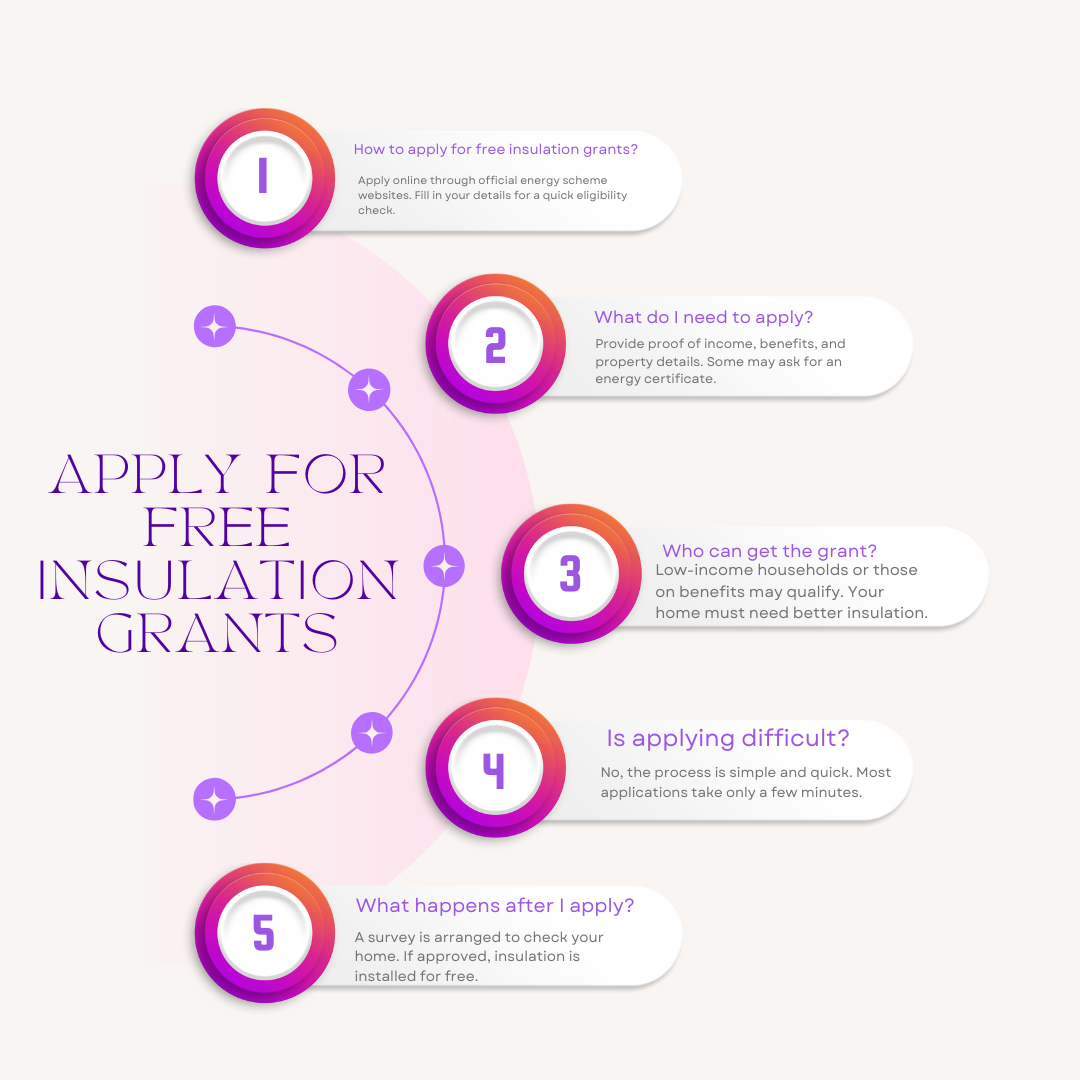Understanding Free Insulation And Energy Efficiency Grants
What Are These Grants?
Free Insulation And Energy Efficiency Grants are government-backed financial aids that help homeowners improve their property’s energy efficiency. Eco GG Ltd These grants often cover the cost of installing insulation, such as loft, cavity wall, and solid wall insulation. They aim to reduce energy consumption, lower carbon footprints, and help homeowners save money on their energy bills. Access to these grants can significantly enhance the comfort and warmth of your home.
Who Qualifies for These Grants?
Eligibility for free insulation grants is often based on factors like household income, age, and health conditions. Low-income families, Free Insulation And Energy Efficiency Grants elderly individuals, and those with specific health issues caused by cold homes typically have priority. However, some grants are available for homeowners in energy-inefficient properties or those who need specific energy-saving measures. To check your eligibility, visit your local government website or contact your energy supplier to get more information.
Benefits of Free Insulation Grants

Lower Energy Bills
One of the biggest advantages of insulation grants is the ability to lower your energy bills. Proper Free Insulation And Energy Efficiency Grants helps to trap heat inside your home, reducing the need for excessive heating during winter. Over time, these savings add up, making your home more affordable to maintain. The reduction in heating costs can make a huge difference, especially in the colder months when energy bills tend to spike.
Increased Comfort
Insulating your home properly not only saves money but also makes your home more comfortable. It reduces drafts, maintains a consistent temperature, and prevents heat from escaping, keeping your home cozy year-round. Whether Free Insulation And Energy Efficiency Grants winter or summer, the temperature inside your home will stay more stable, providing a pleasant living environment. Insulation enhances the overall comfort of your home and prevents energy wastage.
Types of Insulation Covered by Free Grants
Loft Insulation
Loft insulation is one of the most common measures covered by Free Insulation And Energy Efficiency Grants. It prevents heat from escaping through your roof, keeping your home warmer during the colder months. In fact, without sufficient loft insulation, up to 25% of heat can escape through the roof. Free Insulation And Energy Efficiency Grants Government grants often cover the entire cost of loft insulation installationf, helping you create a more energy-efficient and cost-effective home.
Cavity Wall Insulation
Cavity wall insulation is ideal for homes with external walls that have a gap or cavity between them. This insulation type involves filling the cavity with a material that prevents heat from escaping through the walls. Free Insulation And Energy Efficiency Grants grants can cover the installation of cavity wall insulation, which can significantly reduce heating costs. It’s an effective way to make older homes more energy-efficient, particularly for properties built before the 1980s.
How to Apply for Free Insulation Grants

Eligibility Check
The first step in applying for Free insulation program And Energy Efficiency Grants insulation and energy efficiency grants is determining your eligibility. Government and utility companies provide online tools where you can enter your information and check if you qualify. Eligibility may depend on factors like household income, existing insulation, or specific energy inefficiencies. If you’re unsure, contacting your local council or energy supplier for guidance can help clarify whether you’re eligible for a grant.
Application Process
Once you’ve confirmed your eligibility criteria ,the application process is fairly simple. Most applications are completed online through government schemes or energy suppliers’ websites.Free Insulation And Energy Efficiency Grants After submitting your details, a professional assessor may visit your home to evaluate your needs and recommend suitable energy-saving measures. The installer will then carry out the work, ensuring that your home benefits from improved insulation. The cost will be covered under the grant.
Common Misconceptions About Insulation Grants
Grants Are Only for Low-Income Households
One common misconception is that free insulation grants are only available to low-income households. While low-income families and vulnerable individuals may have priority, many grants are also available to homeowners who meet other criteria, such as living in an energy-inefficient home or having specific health concerns. Free Insulation And Energy Efficiency Grants even middle-income households can sometimes access funding, so it’s worth checking eligibility.
The Grants Cover All Costs
Another misconception is that the grants cover 100% of the installation costs. While many grants cover most of the expenses, you may still need to contribute to some costs, especially for more expensive energy-saving measures. Free Insulation And Energy Efficiency Grants Grants Always read the terms and conditions before applying to understand the full extent of the funding provided and any additional costs you may need to bear.
Other Energy Efficiency Measures Supported by Grants
Energy-Efficient Boilers
Aside from insulation, Free Insulation And Energy Efficiency Grants may also cover the installation of more energy-efficient boilers. Replacing an old, inefficient boiler with a modern, energy-efficient model can significantly reduce energy consumption. Government schemes often include boiler replacement as part of the overall energy-saving measures, so if you qualify for an insulation grant, you might also be eligible for a new boiler installation.
Double Glazing
Another energy-saving measure that may be covered by free energy efficiency grants is the installation of double glazing. Double-glazed windows are designed to retain heat inside your home, reducing the need for heating and preventing cold air from entering. Free Insulation And Energy Efficiency GrantsIn addition to making your home more comfortable, double glazing can help lower your energy bills and increase your property’s value, making it a worthwhile investment.
Long-Term Benefits of Free Insulation Grants

Reduced Environmental Impact
One of the long-term benefits ofFree Insulation And Energy Efficiency Grants Insulation And Energy Efficiency Grants is their positive environmental impact. When homes are more energy-efficient, less energy is consumed, resulting in lower carbon emissions. This contributes to the UK’s environmental goals, helping reduce the overall carbon footprint. By taking advantage of these grants, homeowners play a crucial role in the fight against climate change.
Increased Property Value
Another significant long-term benefit of insulating your home is the potential to increase its value. Free Insulation And Energy Efficiency Grantsefficient homes are in high demand, especially among buyers who are conscious of their energy bills and the environment. When it’s time to sell, a well-insulated property will stand out to potential buyers, making it more attractive and potentially increasing its market value.
Frequently Asked Questions (FAQs) About Free Insulation Grants
How Much Can I Save on My Energy Bills?
The savings from Free Insulation And Energy Efficiency Grants can vary depending on the type of insulation installed and the condition of your home. Free Insulation And Energy Efficiency Grants However, homeowners typically see reductions of up to £300-£400 per year on their energy bills after insulation improvements. The more energy-efficient your home becomes, the more significant the savings.
Are Grants Available for Tenants?
Yes, free insulation grants are available to tenants, but only if the landlord agrees to the work being carried out. Free Insulation And Energy Efficiency Grants Tenants living in private or council homes should contact their landlord to discuss applying for grants. Some landlords may be eligible for grants themselves to help improve the property’s energy efficiency.
FAQs
What Are Free Insulation & Energy Efficiency Grants?
Free Insulation And Energy Efficiency Grantsare government-funded programs that help homeowners and tenants improve their home’s energy efficiency. These grants cover the cost of installing insulation, such as loft insulation, cavity wall insulation, and other energy-saving measures like double glazing or new boilers. The goal is to reduce energy consumption, lower heating bills, and reduce your home’s carbon footprint.
How Do I Qualify for Free Insulation Grants?
Eligibility forFree Insulation And Energy Efficiency Grantsdepends on various factors like income, age, and health conditions. Typically, low-income households, elderly individuals, and those with health issues affected by cold homes are prioritized. However, grants may also be available for those living in poorly insulated properties. To determine if you’re eligible, you can contact your energy supplier, visit government websites, or use online eligibility checkers.
How Much Money Can I Save with Insulation Grants?
The savings from free insulation grants depend on the type of insulation installed and the efficiency of your home. On average, homeowners can save up to £300-£400 per year on energy bills after making improvements. Proper insulation reduces heat loss, meaning your heating system doesn’t need to work as hard, lowering your energy consumption and helping you save money in the long run.
Can Tenants Apply for Free Insulation Grants?
Yes, tenants may apply for free insulation grants, but the landlord must approve the work being done. Some grants are specifically designed for tenants, especially those in privately rented or social housing. Tenants should discuss the possibility with their landlord to ensure they can apply for the grant and have the necessary improvements made to their rental property.
What Other Energy Efficiency Improvements Can Be Covered?
In addition to insulation upgrades, free grants may also cover other energy efficiency measures. These can include the installation of energy-efficient boilers, double glazing, smart thermostats, or even LED lighting. Grants vary by program, but they all aim to reduce energy consumption and help homeowners save on energy costs while making their homes more environmentally friendly.






